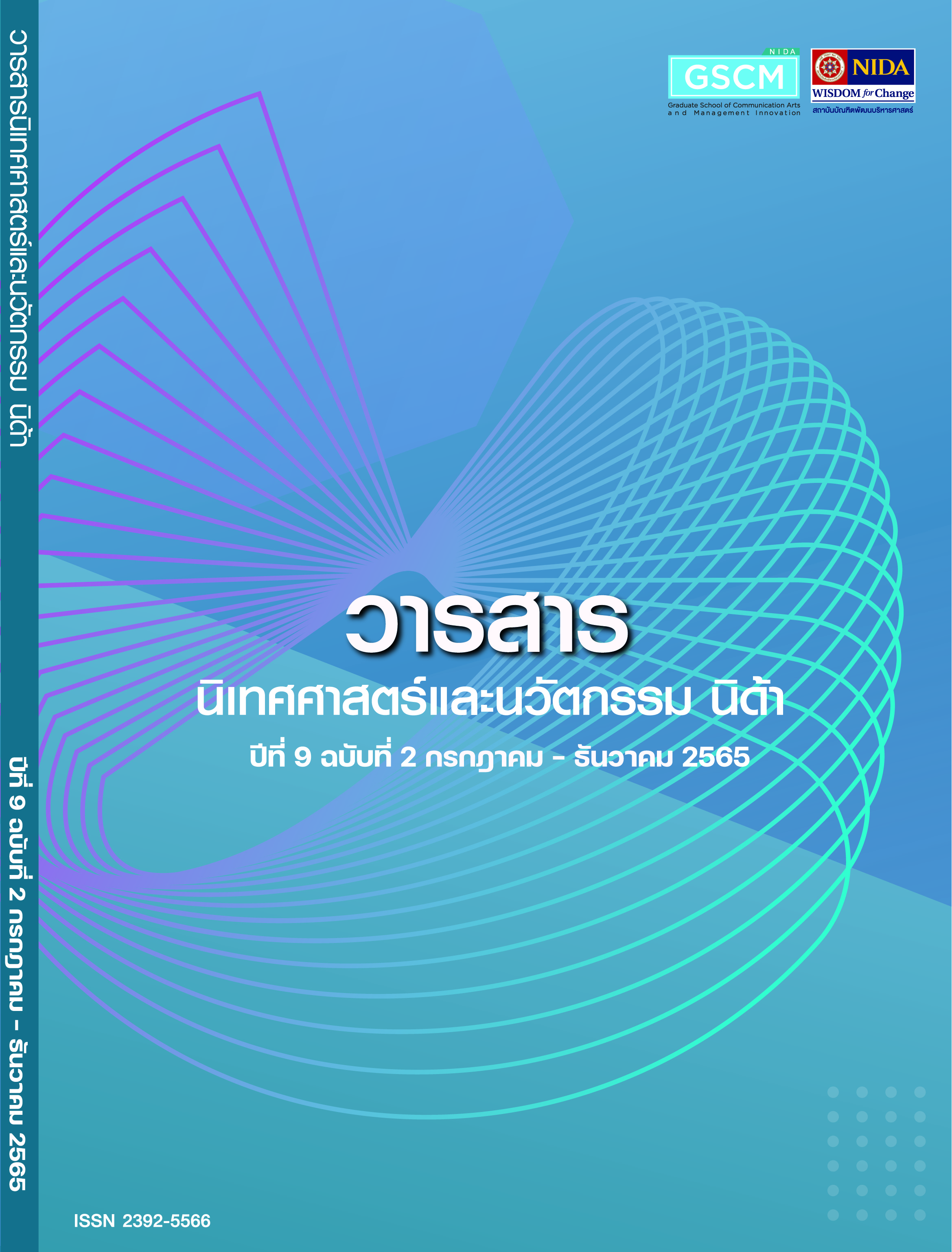The Research for The Development of Digital Advertising Curriculum
Main Article Content
Abstract
This research is aimed to develop a short curriculum for digital advertising creation in the support of media literacy mobilization among online business owners who are college students. The output of the research benefits the government and civic sectors as well as educational institutions as it can be adapted for other target groups. The research findings include the target group’s overall media literacy level and the ‘creation’ aspect of media literacy at the medium level; the target group’s motivation for participating in this curriculum was to exchange knowledge and experience as well as sales techniques; the training should be a two-day workshop focusing on the lecturer’s experience through team-teaching, student’s participation, which was why the number of students per class should not exceed 20. The evaluation of the drafted curriculum met the criteria of assessment, and the results from using the curriculum in the training showed 69.4 percent of students exhibiting better post-test results; in the meantime, the satisfaction of the training was at the high to highest level and participants agreed that the knowledge received was practical.
Article Details

This work is licensed under a Creative Commons Attribution-NonCommercial-NoDerivatives 4.0 International License.
ข้อความและความเห็นในวารสารนิเทศศาสตร์และนวัตกรรม นิด้า เป็นของผู้เขียนแต่ละท่าน มิใช่ของคณะนิเทศศาสตร์และนวัตกรรมการจัดการ สถาบันบัณฑิตพัฒนบริหารศาสตร์
References
คณะทำงานวางแผนจัดทำกรอบสมรรถนะหลักสูตรการศึกษาขั้นพื้นฐาน. (2562). แนวทางการพัฒนาผู้เรียนให้เกิดสมรรถนะหลักที่จำเป็นต่อชีวิต. ในคณะทำงานวางแผนจัดทำกรอบสมรรถนะหลักสูตรการศึกษาขั้นพื้นฐาน, รายการผลงาน สื่อ สิ่งพิมพ์ ประชาสัมพันธ์ และเผยแพร่กรอบสมรรถนะผู้เรียน ระดับการศึกษาขั้นพื้นฐาน (น. 5-9). เข้าถึงได้จาก https://www.thaiedreform.org/wpcontent/uploads/2019/08/Core_competency_09.pdf -
เจพี วัน คอนซัลแทนท์. (2561, 20 สิงหาคม). กทปส. ผลักดัน 7 โครงการ ผ่าน 7 หน่วยงาน หวังให้สังคม และประชาชนรู้เท่าทันสื่อในยุค 4.0 [ข่าวเทคโนโลยี]. สืบค้นจาก https://www.ryt9.com/s/prg/2874130
ชัชฎา อัครศรีวร นากาโอคะ, และกฤชณัท แสนทวี. (2562). ปัจจัยที่มีอิทธิพลต่อการรู้เท่าทันข้อมูลและสื่อดิจิทัลของเยาวชนในเขตกรุงเทพมหานคร. วารสารวิชาการนวัตกรรมสื่อสารสังคม, 7(1), 55-62.
โต๊ะข่าวไอที-ดิจิทัล. (1 สิงหาคม 2564). เปิดอินไซต์ ผู้ค้าออนไลน์ 5 กลุ่มในอาเซียน 'โควิด' ปลุกแรงกระเพื่อม. เข้าถึงได้จาก กรุงเทพธุรกิจ: https://www.bangkokbiznews.com/tech/952181
ทิศนา แขมมณี. (มกราคม 2562). 10 สมรรถนะหลัก ปั้นเด็กไทยฉลาดรู้ อยู่ดีมีสุข มีความสามารถสูง และใส่ใจสังคม. ในคณะทำงานวางแผนจัดทำกรอบสมรรถนะ., รายการผลงาน สื่อ สิ่งพิมพ์ประชาสัมพันธ์ และเผยแพร่กรอบสมรรถนะผู้เรียน ระดับการศึกษาขั้นพื้นฐาน (น. 3-4). เรียกใช้เมื่อ 13 กันยายน 2565 จาก https://www.thaiedreform.org/wp-content/uploads/2019/08/Core_competency_09.pdf
นันทิดา โพนจ้อย. (2557). อินดี้" รวยเกินวัย กำไรเกินเท่าตัว (SMEs ชี้ช่องรวย) [บทความ]. สืบค้นจาก https://money.kapook.com/view95153.html
ประชาชาติธุรกิจ. (30 ธันวาคม 2564). ทิศทางอีคอมเมิร์ซปี’65 ทะลุ 9 แสนล้าน โซเชียล-ไลฟ์สด แรง. เข้าถึงได้จาก prachachat.net: https://www.prachachat.net/ict/news-831222
มนต์ ขอเจริญ, และณัทธสิฐษิ์ สิริปัญญาธนกิจ. (2559). การรู้เท่าทันการสื่อสารยุคดิจิทัลของประชาชนในเขตกรุงเทพมหานคร. วารสารนิเทศศาสตร์ธุรกิจบัณฑิตย์, 10(2), 205-231.
มนตรี ศรีวงษ์. (2560, 6 พฤษภาคม). 11 อาชีพสร้างรายได้ สไตล์นักศึกษา [บทความ]. สืบค้นจาก http://www.thaismescenter.com/11-อาชีพสร้างรายได้-สไตล์นักศึกษา/
มูลนิธิการศึกษาเพื่อชีวิตและสังคม. (2561). โครงการพัฒนาศักยภาพเด็กและเยาวชนชาติพันธุ์เท่าทันสื่อ สร้างสุข (สร้างเด็ก สร้างสื่อ สร้างสุข). สืบค้นจาก http://www.elsthai.org/causes/sharing-for-learning-to-development/
พรทิพย์ เย็นจะบก. (2552). ถอดรหัสลับความคิดเพื่อการรู้เท่าทันสื่อ. กรุงเทพมหานคร: ออฟเซ็ทครีเอชั่น.
สุภาวดี พรหมมา. (2562). การวิจัยและการพัฒนาหลักสูตรฝึกอบรมเพื่อการรู้เท่าทันโฆษณาผ่านสื่อสมัยใหม่ของเยาวชน. วารสารวิจัยราชภัฏพระนคร, 14(2), 359-372.
สำนักงานปลัดกระทรวงการอุดมศึกษา วิทยาศาสตร์ วิจัยและนวัตกรรม. (2561). สถิติอุดมศึกษา. [ออนไลน์]. ได้จาก: http://www.info.mua.go.th/info/
สำนักงานพัฒนาธุรกรรมทางอิเล็กทรอนิกส์ (สพธอ.). (2563, 22 ตุลาคม). ชี้ช่องขาย: ช่องทางซื้อของออนไลน์สุดฮิต กับโอกาสที่ผู้ขายห้ามพลาด [บทความ]. สืบค้นจาก https://www.etda.or.th/th/Knowledge-Sharing/e-Commerce/ThailandeCommerceplatform2020.aspx
เส้นทางเศรษฐีออนไลน์. (2562, 13 มกราคม). โฆษณาเกินจริง “ยา-ผลิตภัณฑ์เสริมอาหาร” กำลังคุกคามสังคมไทยยุค 4.0. [บทความ] สืบค้นจาก https://www.sentangsedtee.com/exclusive/article_99687
เสริมศักดิ์ ขุนพล. (2563). สื่อโฆษณาแฝงในการตลาดบนสื่อสังคมออนไลน์ของเครื่องดื่มแอลกอฮอล์ที่มีผลต่อการดื่ม และการรู้เท่าทันสื่อของเยาวชนระดับอุดมศึกษาในพื้นที่จังหวัดสงขลา. วารสารวิชาการนิเทศสยามปริทัศน์, 19(1), 55-67.
อภิญญา เพ็ชรศรี. (2561). การวิจัยและพัฒนารูปแบบการรู้เท่าทันสื่อโฆษณาของธุรกิจจำหน่ายอาหารฟาสต์ฟู้ด และอาหารขยะในเด็กวัยเรียน อำเภอเขาชัยสน จังหวัดพัทลุง. วารสารวิชาการแพทย์ เขต 11, 32(2), 935-944.
อาภัสรี บัวประดิษฐ์, และสุรศักดิ์ เสาแก้ว. (2563). ผลของโปรแกรมพัฒนาการรู้เท่าทันสื่อโฆษณาต่อพฤติกรรมการเลือกบริโภคผลิตภัณฑ์สุขภาพในกลุ่มผู้สูงอายุที่ใช้แอปพลิเคชันไลน์ จังหวัด นครนายก. วารสารเภสัชกรรมไทย, 12(4), 932-942.
อารมย์ สุกดิษฐ์. (2559). ความรู้เท่าทันสื่อทางด้านโฆษณา กรณีศึกษาการโฆษณาแฝงที่ปรากฏในรายการข่าวและรายการบันเทิงของสถานีโทรทัศน์ (วิทยานิพนธ์ปริญญาดุษฎี บัณฑิต). สาขาวิชาการประกอบการ บัณฑิตวิทยาลัย มหาวิทยาลัยศิลปากร, นครปฐม
SalesMatchup. (2563). 12 ขั้นตอน ขายของออนไลน์ ให้ยอดปัง ตังค์มาเอง 2020 [บล็อก]. สืบค้นจาก https://www.salesmatchup.com/blog/12ขั้นตอนขายของออนไลน์ให้/
Barrot, J.S., Llenares, I.I., and del Rosario, L.S. (2021). Students’ online learning challenges during the pandemic and how they cope with them: The case of the Philippines. Educ Inf Technol. doi:https://doi.org/10.1007/s10639-021-10589-x
Friedman, Jordan. (2020). Tackle challenges of online classes due to COVID-19 [article]. Retrieved from: https://www.usnews.com/education/best-colleges/articles/how-to-overcome-challenges-of-online-classes-due-to- coronavirus
Hobbs, R. (2010). Digital and media literacy: A plan of action. Journal of Adolescent & Adult Literacy, 52(6), 471-481.
Kemp, Simon. (2020, 18 February). DIGITAL 2020: THAILAND [statistics report]. Retrieved from https://datareportal.com/reports/digital-2020-thailand
Klawitter, Anna. (2020). 5 challenges students face with online learning and how to overcome them. Retrieved from https://www.meratas.com/blog/5-challenges-students-face-with-remote-learning
Nuparioj, Nudee. (2015). Media literacy needs assessment for Thai generation Y. Dhurakij Pundit Communication Arts Journal, 9(2), 147-179.
Potter, W. J. (2014). Media literacy. 7th ed. Thousand Oaks, CA: Sage
United Nations Educational, Scientific and Cultural Organization (UNESCO). (2013). Global media and information literacy assessment framework: country readiness and competencies. Paris, France: United Nations Educational, Scientific and Cultural Organization (UNESCO). Retrieved from https://unesdoc.unesco.org/ark:/48223/pf0000224655
United Nations Educational, Scientific and Cultural Organization (UNESCO). (2013). Global media and information literacy assessment framework: country readiness and competencies. Paris, France: United Nations Educational, Scientific and Cultural Organization (UNESCO). p.57. Retrieved from https://unesdoc.unesco.org/ark:/48223/pf0000224655
Yamane, T. (1973). Statistics: an introductory analysis. New York: Harper & Row.


